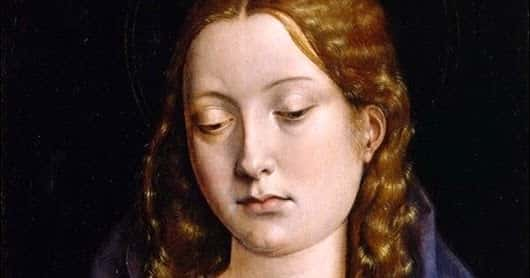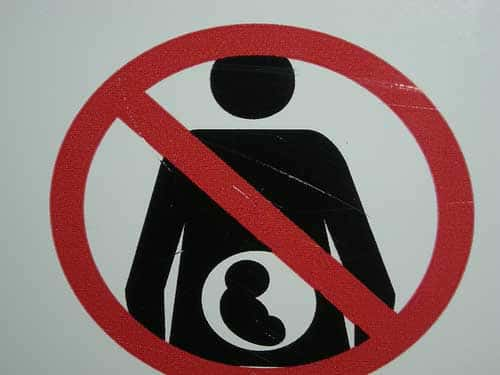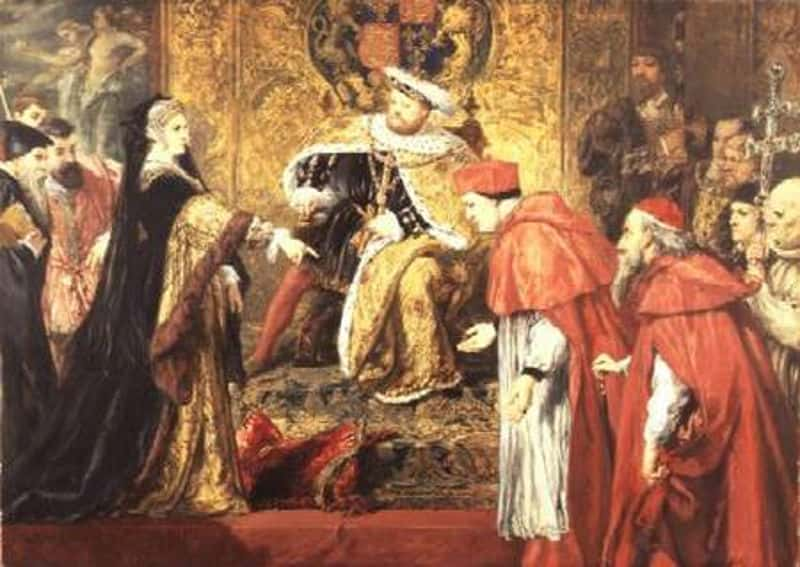“Nature wronged her in making her a woman. But for her sex she could have surpassed all the heroes of history.”—Thomas Cromwell
Catherine of Aragon was Henry VIII’s first wife and his longest-lasting Queen Consort of England. One might remember her as the dark, pious lady whom Henry “divorces” in all those period dramas to marry Anne Boleyn. Of course, that’s a broad stroke. It’s difficult to extricate Catherine the living woman from the stereotype she’s inspired about martyred, neglected, rejected wives in historical fiction. For that reason, it’s even more ironic that Catherine’s life was the most documented, by contemporaries, of all Henry’s queens.
Born in Spain to the House of Trastamara, Catherine grew up against the backdrop of European exploration and the Inquisition. Her marriage and life in England would make her a notable figure in the affairs of Scotland, France, Spain, the Holy Roman Empire, and the Pope himself. Sure, Catherine is mostly remembered as the first doomed Queen of Henry VIII, but the woman inspires much in terms of her own actions and character. After all, Henry VIII may have rejected Catherine, but it was Catherine who first rejected Henry as the Supreme Head of the English Church. Read on for 43 scandalous facts about the epic life of Catherine of Aragon, the first wife of Henry VIII.
43. You May Now Exchange Pacifiers
In 1489, at just four years old, Princess Catherine of Aragon became engaged to the Prince of Wales. Her betrothed was not the future Henry VIII, but rather it was his older brother, Arthur. Raised with a lifelong expectation that she would be Queen of England, is it any wonder Catherine would never let the title go?
 Dreamstime
Dreamstime
42. Conquering Couple
A lot of imperialist history happened in the background of Catherine’s childhood. Her parents were Isabella of Castile and Ferdinand of Aragon, aka the “Catholic Monarchs.” They were so-called by the Pope himself because of their oft-brutal methods in upholding Roman Catholicism as Europe’s dominant religion. Her parents also sponsored Christopher Columbus’s voyages to claim land in South America.
41. Rough Terms of “Service”
Among the early-modern Spanish upper-class, slave ownership was not uncommon. And Henry VIII’s first wife was no exception. In 1491, a slave from the newly colonized Canary Islands served in baby Catherine’s household. Likewise, two slave girls accompanied Catherine on her maiden voyage to England.
40. Blue Blood, Red Hair
Catherine of Aragon did not sport the swarthy complexion and black hair that Tudor-themed film and television so often ascribes to her. In most contemporary accounts, Catherine’s is described with fair skin, blue eyes, and reddish hair. Nevertheless, the imagining of Henry VIII’s first bride as a dark, gloomy, rejected foreign wife looms large over the ginger reality.
39. The More You Know
Catherine and her sisters were among the most well-educated princesses of Europe. Taught by the famed cleric Alessandro Gerladini, she mastered multiple languages, from Spanish and Latin to French and Greek. In addition, she was schooled in arithmetic, law, classical literature, genealogy, history, philosophy, and theology.
38. The Romantic Languages
For years, Catherine and Arthur, Prince of Wales wrote letters to each other in Latin. Unfortunately, when they finally met in 1501, the young couple discovered they could not actually speak to each other. They had been taught different models of pronunciations.
 Notre Dame Sites - University of Notre Dame
Notre Dame Sites - University of Notre Dame
37. Public Doings
Catherine and Arthur’s wedding night was the only public royal bedding of the English in the 16th century. That makes it even more ironic that what happened after the couple was left alone was one of the biggest legal questions of the European 16th century…
36. Down for the Dowry
Good thing Henry VII loved money. In April 1502, Prince Arthur died, possibly from sweating sickness. Less than 5 months after her wedding, Catherine found herself a 16-year-old widow. However, her father-in-law, Henry VII, wasn’t going to refund that huge 200,000 crown dowry without a fight! When he was freshly widowed himself, Henry VII briefly considered marrying his late son’s wife in order to keep her sweet dowry—that would’ve made £5 million in 2007 cash.
35. Let’s Keep This In-House
Just one year after Prince Arthur’s death, Catherine was re-engaged to House Tudor via his brother, the 11-year-old future Henry VIII. The technicality of their union being incest (maybe) was overcome with a handy dispensation by the Pope himself, who granted the “A-OK” and even allowed for the possibility that Catherine had consummated her first match.
34. Standing by Her Hymen
For her whole life, Catherine would stand by her girlhood testimony that she never consummated her marriage with the 15-year-old Arthur. Ergo, the marriage was not valid, and she was free to marry his brother.
33. The Daughterly Diplomat
In 1507, Catherine’s father appointed her as the Aragonese ambassador to England. This made Catherine the first female ambassador in European history.
32. Being Single Again is Purgatory
Catherine endured 7 years of aristocratic poverty between her marriages. Soon after her engagement to Henry, Catherine’s powerful mother died. Isabella of Castile’s death lowered Catherine’s value on the marriage market, and her dad was defaulting on the rest of her dowry. As a result, Henry VII held Catherine as his unofficial prisoner London, and she struggled to feed her own servants.
31. Drop Her Like Her Aunt Is Hot
In one swoop, Henry VIII made his sister-in-law into his wife and his fiancée into his niece. Hard to follow? Give us a chance: when the 18-year-old Henry ascended to the throne in 1509, one of the first things he did was marry the 23-year-old Catherine. As Henry would come to do often, he followed his heart at someone else’s expense. To marry his first wife, Henry broke off his engagement to Eleanor of Austria, whose aunt happened to be Catherine herself. Awkward.
30. Stash the ‘Stache
In 1519, Henry VIII caused an international relations faux-pas thanks to his love for Catherine and a beard-growing pact gone wrong. At the time, Henry and the King of France had an alliance and agreed not to shave until they finally met in person. However, Catherine did not dig her husband’s “au naturel” look and told him to shave it off. Henry obeyed. This was a scandal to the French, since it appeared that Henry symbolically snubbed them for Spanish interests! Fortunately, the drama passed over, and the King of France’s mom publicly assured that her son and Henry’s “love is not in their beards, but in their hearts.” If only the other international hoopla between Henry and Catherine had ended so sweetly.
29. Phantom Fetus
Catherine had a child who “disappeared.” Kind of. In January 1510, she suffered her first of many miscarriages. However, her stomach remained puffy, probably from infection, which caused her doctors to believe that she had been carrying twins and one had survived, even as Catherine continued to menstruate—prenatal care was…experimental in 1510. Two months later, Catherine went into seclusion for the birth. But of course, no child arrived.
28. Woe Is Womb
Why did so many of Catherine’s pregnancies fail? In recent years, some thinkers have put forth a theory that Catherine suffered from anorexia. During her young widowhood, uncertainty and poverty made Catherine frequently ill and depressed. This physical trauma may have led to future fertility problems. Sounds like a stretch, but it’s worth noting yet another terrible thing that happened to Catherine of Aragon.
27. Baby Blues
Altogether, Catherine endured 7 pregnancies over just 10 years. Every single child died in birth or early infancy, except for a daughter—from her fifth pregnancy—named Mary, born in 1516.
 YouTube
YouTube
26. Looks Fade, But Words Scar Forever
Like her husband, Catherine did not age well. In her youth, Catherine was regarded as a great beauty. Thomas More once said “there were few women who could compete with the Queen [Catherine] in her prime” and her confessor called her “the most beautiful creature in the world.” By her 30s, however, Catherine had understandably gained weight and visible markers of stress from endless failed pregnancies; a Venetian ambassador courteously described her as “somewhat stout.” Less kindly, King Francis I of France outright called his rival’s wife “old and deformed” compared to her “young and handsome” husband, who was only 5 years her junior.
25. Global City
In 1501, the first recorded Africans to arrive in London came via Catherine’s bridal entourage. Among these attendants included the famous 16th-century trumpeter, John Blanke.
24. Closed from Business
By the early age of 40, Catherine had already gone through menopause. That meant she would never give Henry his desperately longed-for male heir.
23. Out With the Old…
By the mid-1520s, Henry had enamored himself with Catherine’s lady-in-waiting, Anne Boleyn. Anne was not the only reason for their ensuing divorce, of course, but it’s probably no coincidence that Henry formally petitioned for annulment around this time.
22. No Hand-Me-Down Spouses
Henry tried to annul his marriage to Catherine based on Leviticus 20:21. This Bible passage outlaws the marriage of oneself to one’s brother’s widow and condemns the couple to childlessness. Catherine had been briefly, previously married to Henry’s brother Arthur 20-odd years before at that point. Although Henry and Catherine weren’t literally childless—hi, Princess Mary!—the lack of sons was proof enough, for Henry at least, of their marriage’s invalidity.
21. What’s the Matter?
Henry and Catherine’s divorce trial became known around in Europe as “The Great Matter.” It’s a name that’s at once discrete for its circumstances—a man ditching his wife—yet glorious for the people involved—they were royals, so everything must be “great”.
20. Hostile Networking
It was touchy enough that Catherine’s nephew was Emperor Charles V of the Holy Roman Empire. That Charles was keeping the Pope as his hostage in 1527 made things even harder for Henry to get his annulment. Obviously, Henry’s envoy had a hard time gaining access to the Pope on behalf of his master.
19. Sure, Henry
Into November 1528, Henry assured everyone he was only divorcing Catherine out of biblical conscience. Or as he declared, “if I were to marry again if the marriage might be good I would surely chose [Catherine] above all other women.” This was after he temporarily sent his queen-in-waiting, Anne Boleyn, to the country as the divorce was still being judged by the Papal legate. It didn’t look convincing.
18. In It to Win It (For Herself?)
Was Catherine’s resistance to divorce Henry out of complete love and selflessness? She acted at least a bit for her own sense of status. In 1528, the Pope and his envoy Cardinal Lorenzo Campeggio offered Catherine a dignified “out.” They suggested that Catherine enter a nunnery, which was a comfortable form of retirement for infertile or inconvenient noblewomen. In such an arrangement, her daughter Mary would still be a legitimate heir to the throne while Henry could be free to take another wife and have more children. Obviously, staying Queen meant a little more to Catherine than just defending her daughter’s rights because she did respond, “God never called me to a nunnery. I am the King's true and legitimate wife."
 Ottawa Citizen
Ottawa Citizen
17. Don’t Even Try It, Dude
Anne Boleyn did not underestimate Catherine’s intelligence. In one occasion, Henry got into a verbal tiff with Catherine that ended with her using her classical education to verbally annihilate him. Henry tried to lick with wounds with some soothing from Anne, but even she told the king, “Did I not tell you that whenever you disputed with the Queen she was sure to have the upper hand? I see that some fine morning you will succumb to her reasoning, and that you will cast me off.” To paraphrase the elegant early-modern talk from Anne, “She’s smarter than you, and you brought it on yourself.”
16. I Win?
Married to Henry for 23 years, 11 months, and 19 days, Catherine is ultimately the longest-serving of Henry VIII’s six queens.
15. She Has a (Needle)Point
Years into their estrangement, Catherine was still sewing Henry’s shirts for him, even though he was basically living with Anne Boleyn. When Anne found out, she was understandably upset. Henry, however, thought it was NBD because Catherine had always made his shirts. Why let a little thing like emotional adultery stop a good thing like free needlework?
14. Surprise Staycation
Henry VIII was truly a guy to cut and run. In July 1531, he left his wife and daughter on a hunting trip to Woodstock and never came back. Practically overnight, he made the decision to move the court with him while leaving Queen Catherine and Princess Mary behind in Windsor. In a letter, Catherine complained that he didn’t even wake her up to say goodbye. She would never see him again.
13. It’s Me or The Church
By splitting with Catherine, Henry had to split with the Roman Catholic Church’s authority of English civil and canon matters. As a result, the King’s “Great Matter” should be seen as only a piece in the colorful, violent mosaic of the Reformation happening across Europe against Papal authority.
12. High Royal Turnover
In May 1533, after seven years of dramatic divorce depositions, Archbishop Thomas Cranmer officially declared Catherine and Henry’s marriage null and void. Just five days later, the secret marriage between Henry VIII and Anne Boleyn was declared totally valid. Now that’s a short onboarding period.
11. Shame & Names
Upon her annulment, Catherine was demoted to the title of “Princess Dowager of Wales,” which referred to her “real” status as widow to Henry’s brother, Arthur. To the end of her life, she would refuse this title and insist her servants refer to her as the Queen.
10. Bummer Ending
Life as a divorcée was not kind to Catherine. Thus, she refused to be kind to herself, at least physically. In her last months, the ex-queen was isolated in Kimbolton Castle, where she fasted constantly and wore nothing but a hair shirt from the Order of St. Francis. It was prickly living but demonstrated Catherine’s commitment to arguably the last thing she could count on, that being her Catholic faith.
9. BFFs ‘til the Great Beyond
Maria de Salinas was Catherine’s lifelong friend from Spain. She was there for Catherine’s wedding and braved winter storms—and potential imprisonment—to see Catherine to a kinder death. By Christmas 1535, Catherine was on her deathbed, and Maria refused to let her die alone. Despite the king’s orders to stay away from Catherine, Maria spent her New Year’s 1536 traveling nearly 60 miles on horseback from London to see her friend. At the door, Maria lied and told guards she had “lost” the paperwork which gave her the king’s permission to enter. Finally, Maria braved it through the door, locked it behind her, and saw her lifelong buddy into the next life.
8. Goodbye and Yellow!
According the Imperial Ambassador Eustace Chapuys, Henry “honored” the death of his ex-wife, to whom he was married for over 20 years, by dressing head-to-toe in yellow silks and declaring, “God be praised that we are free from all suspicion of war!” since the divorce had put him at odds with her nephew, Emperor Charles of Spain. Some people have tried to suggest that yellow is the Spanish color for mourning, but the verdict is still up in the air.
7. Ghost Girl
The ghost of Catherine of Aragon is said to haunt Castle Lodge, Ludlow, where the young bride stayed in her first, brief marriage to Arthur, Prince of Wales. Visitors report seeing an apparition of a teenaged girl in Tudor-era clothing. She floats through both the halls and the nursery that she never got to fill, perhaps longing for more hopeful times.
6. Vitamin Vindication
Catherine’s tomb in Peterborough Cathedral is open to the public, and, accordingly, it is constantly covered in pomegranates. This isn’t desecration; pomegranates were Catherine’s Trastamara family sigil. Perhaps most defiantly, her grave bears the title, “Katharine Queen of England.”
5. Head First into Her Defense
During her tenure, Catherine was a very popular queen. Figures like Thomas More and John Fisher were executed—and later canonized—for refusing to sign the Act of Succession which, among other things, declared that Henry’s marriage to her was invalid.
4. Unlikely Allies
Ironically, Martin Luther was firmly on the “pro-Catherine” camp of the King’s Great Matter. That is wild if you remember how Luther was one of the biggest Protestant Reformers of the 16th century and Catherine was one of Catholicism’s most ardent defenders. Not to mention how Henry’s split from Catherine abetted England’s divorce from Rome.
 Informatii si mesaje - WordPress
Informatii si mesaje - WordPress
3. Girl Gang
Throughout the Great Matter, Catherine’s popularity with women was readily evident. The Venetian diplomat Francesco Sanuto once claimed that an angry mob of “seven to eight thousand women” tried to seize and kill Anne Boleyn, presumably in Catherine’s name, as the younger lady fled by boat. Of course, this story has been raised with suspicion in recent years, since Sanuto’s is the only account of such a huge event, but the tall tale’s popularity testifies to Catherine’s appeal as the “spurned woman” against Anne’s “other woman.” They were the Jen and Angelina of their time!
2. My Bloody Bro-in-Law Valentine
In 1513, a heavily pregnant—for real this time—Catherine rode in full armor to address troops at the Battle of Flodden. Henry was away at a foreign war, leaving Catherine as regent. The Scottish army, led by Henry’s brother-in-law King James IV, took advantage of his absence and tried to attack the kingless nation. Catherine utterly destroyed the Scots and sent a bloody piece of James’s coat to Henry for use as a war banner. She had wanted to send her hubby his brother-in-law’s body itself, but that was too much for those weak-bellied Englishmen—her words. Remember, this bloodshed was during their happy days!
1. Heart of Darkness
For its time, Catherine’s cause of death was ambiguous. Her embalmer noticed the corpse was in perfect health—save for her heart, which had turned black. That led some people to whisper about poison. Today, historians agree generally agree that Catherine died of heart cancer, which—considering the circumstances of her life—appears too poetic to be true.
Sources: 1, 2, 3, 4, 5, 6, 7, 8, 9, 10, 11, 12, 13, 14, 15, 16, 17, 18, 19, 20, 21, 22, 23, 24, 25, 26, 27, 28, 29

















































